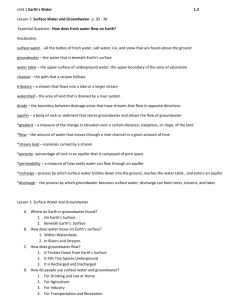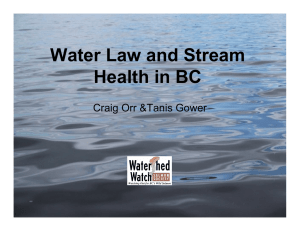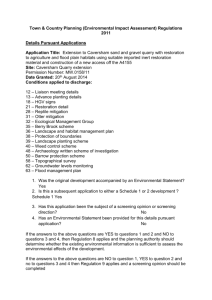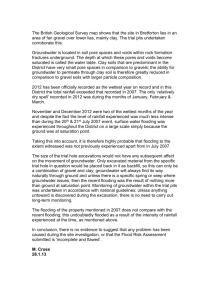Water Supply, Use, and Management
advertisement
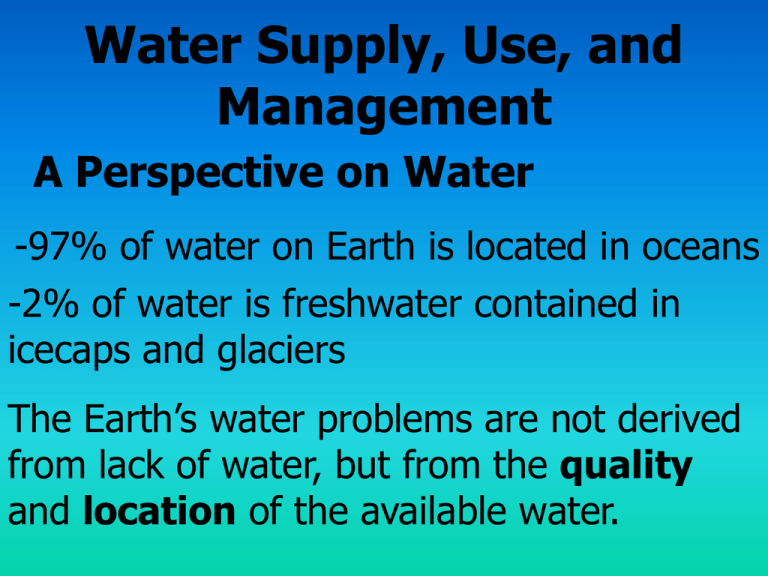
Water Supply, Use, and Management A Perspective on Water -97% of water on Earth is located in oceans -2% of water is freshwater contained in icecaps and glaciers The Earth’s water problems are not derived from lack of water, but from the quality and location of the available water. The amount of water available for all of the people, plants and animals is less than 1% of the total. The consumption rate of freshwater on Earth is accelerating rapidly. 1975: Total Human use of water was about 3,850 km3/yr Today: Total Human use of water is about 6,000 km3/yr Water: a very cheap resource Water has always been a favorite resource for man, and has been used in great quantities. Because of its great abundance, water has been a very cheap resource, and fully exploited. Ex: Las Vegas, Nevada It was always cheap enough to subsidize large canals and aqueducts to carry water to where we needed it. Ex: Roman aqueducts to carry water long distances from wells to cities. Recent events have shown that water is NOT an unending supply, and that our misuse of the resource is causing us to lose our supply of drinking water. The question now is, how do we manage our dwindling resource, to maintain supplies large enough? Wars have been fought over the use of water, and will only get worse if we don’t get it right. The U.S. Water resources Council estimates that water use in the U.S. will exceed our surface supplies by 13% in 2020. That means that we are increasingly going to rely on groundwater as a source of our drinking water. Groundwater generally refers to water below the water table, where saturated conditions exist. ( i.e. deep in the ground) Water from the surface evaporates, runs off, or soaks in and is transported underground. Areas where water infiltrates the ground are called recharge zones. Areas where water seeps out of the ground, such as springs, are called discharge zones. An aquifer is an area underground with spaces to hold water, such as in gravel , sand, or fractured rock deposits. Effluent vs. Influent Streams Effluent streams are maintained during dry seasons by seepage from groundwater. Influent streams are entirely above the water table, and flow only in response to precipitation. Influent streams are also sometimes called ephemeral streams, because they don’t flow all year. Groundwater and Surface Water Interactions Because groundwater and surface water are so interrelated, pollution of one usually causes the pollution of the other. The quality of both is reduced by urban and agricultural runoff, which add nutrients and fertilizers, oils from roads, and nutrients from treated waste. Pollution within a groundwater resource may last a very long time, even if the pollution is stopped, due to the slow turnover rate of groundwater. Groundwater Overdraft In areas where water is being removed faster than it is being replaced, a condition called overdraft exists. Overdraft can lead to a variety of ecological problems, such as damage to river and wetland ecosystems, and land subsidence. In the Texas-Oklahoma High Plains area, pumping of water for agriculture has lowered the aquifer more than 15 meters in some areas. Water Level Changes Due To Overdraft Of the Ogallala Aquifer. Trends in Water Usage Withdrawals of surface water in the U.S. far exceed withdrawals of groundwater. Water usage reached a peak in 1980, and has leveled off, despite an increase in total population. This suggests an increase in efficiency and better management and conservation. Water Use -Off stream: water removed from its source -often returned after use (industrial cooling) Consumptive Use: similar to off-stream, but is used up by plants, animals, or industry In-stream: navigation, hydroelectric generation, fish and wildlife habitat Water Diversion: How much can be removed from a body of water without damaging the ecosystem? EX: Pacific Northwest, where salmon and trout are declining due to water diversions for agriculture. EX: the Aral Sea, where water was diverted from two rivers for cotton agriculture. Trends in United States fresh groundwater and surface-water withdrawals and human population (1950-1995). The greatest consumers of water are agriculture and the thermoelectric (power generation) industry. Although the use by agriculture and industry has leveled off, use for public water supply has risen. This rise is due to the increased population. Fig 20.11 Trends in United States water withdrawals by water-use category and total withdrawals (19601995). Man’s Impact on Water Movement Channelization: straightening, deepening, clearing and widening of an existing stream. May also involve lining the canal with cement stone or metal to prevent erosion. Effects: Water movement is much faster, with less structure for aquatic habitat. Lower numbers of aquatic insects, fish and Birds. The channelization of a stream results in a degraded ecosystem, more prone to flooding and erosion. Increased downstream flooding, due to the increased water flow, and lack of things to slow the water down. 2003: Parts of the Brandywine, which were Channelized, are returned to their natural Channels, and rocks are returned. FROM TO Canals and the environment Canals are not the same hydrologically as streams or rivers. Canals tend to be straighter, with steep sides, and are designed to carry water from one place to another. The water in canals often moves quickly, and they can present a safety hazard to people and animals The development of canals has led to the movement of unwanted organisms from place to place Ex: snails that carry disease (schistosomiasis)in Egypt. Theses snails were flushed out each year by flooding of the Nile, but canals have left them with areas that are not flushed, so they stay. Ex: The Panama Canal has allowed species from the Atlantic and pacific to mix, reducing diversity of marine areas around both ends of the canal. Building on a Floodplain Floodplains are areas along rivers where flood Waters can go, and lose their sediment. They are areas which should NOT be built on, because eventually they WILL flood. They are generally designated by the number of years between anticipated flood. EX: A “100 year flood plain” is expected to be flooded every 100 years or so. Building on a floodplain also contributes to flooding downstream , as the additional water runoff is added to the stream. Areas which previously did not flood will now flood due to the increased water volume, which should have been absorbed by the floodplain upstream.




